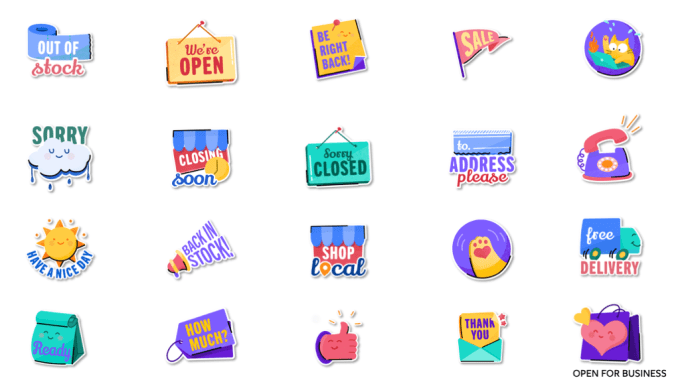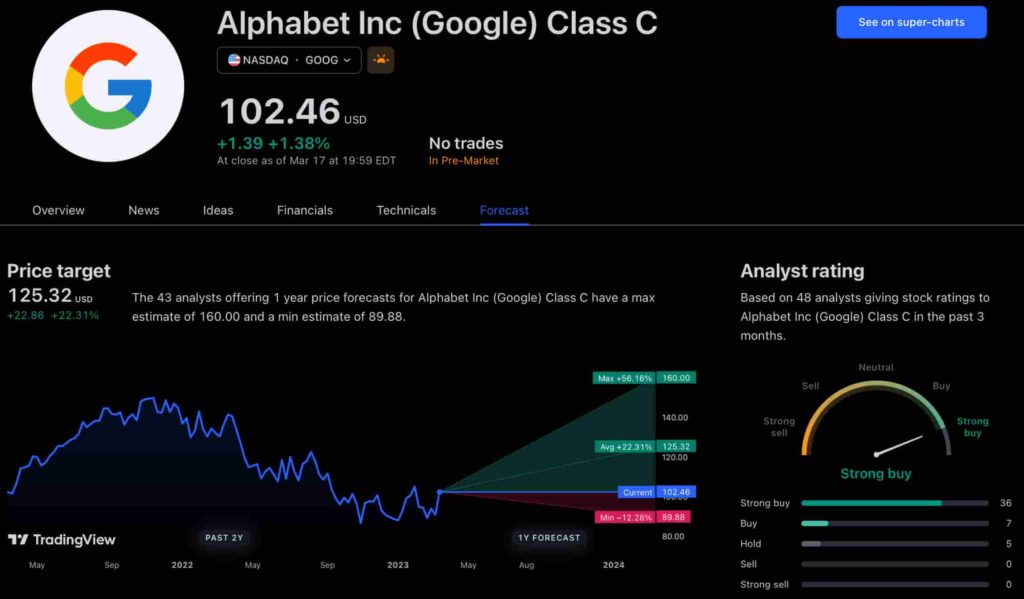The new app is called watchGPT and as I tipped off already, it gives you access to ChatGPT from your Apple Watch. Now the $10,000 question (or more accurately the $3.99 question, as that is the one-time cost of the app) is why having ChatGPT on your wrist is remotely necessary, so let’s dive into what exactly the app can do.
NEWS
WhatsApp Business, now with 50m MAUs, adds QR codes and catalog sharing

The global COVID-19 health pandemic has raised the stakes for businesses when it comes to using digital channels to connect with customers, and today WhatsApp unveiled its latest tools to help businesses use its platform to do just that.
The Facebook-owned messaging behemoth is expanding the reach and use of QR codes to let customers easily connect with businesses on the platform, providing them also with a series of stickers (pictured below) to kick off “we’re open for business” campaigns; and it’s made it possible for businesses to start sharing WhatsApp-based catalogs — dynamic lists of items that can in turn be ordered by users — as links outside of the WhatsApp platform itself.

The new launches come at WhatsApp’s business efforts pass some significant milestones.
WhatsApps’ profile as a formal platform for doing business is growing, albeit slowly. The WhatsApp Business app — used by merchants to interface with customers over WhatsApp and use the platform to market themselves — now has 50 million monthly active users, according to Facebook. Its two biggest markets for the service are India at over 15 million MAUs and Brazil at over 5 million MAUs, while catalogs specifically have had 40 million viewers.
On the other hand, WhatsApp has hit some stumbling blocks with features it’s tried to put into place to grow those numbers faster and boost usage among businesses.
Specifically, last month WhatsApp launched payments in Brazil, its first market, aimed not just at users sending each other money but merchants selling goods and services over the platform. But just nine days later, Brazilian regulators blocked the service over competition concerns, and it has yet to be restored pending further review. (India, which many had thought would be the first market for payments, is now part of a bigger global roadmap for rolling out payments.)
To put WhatsApp Business app’s usage numbers into some context, WhatsApp itself passed 2 billion users in February of this year. In that regard, hitting 50 million MAUs of the WhatsApp business app in the two years since it’s launched doesn’t sound like a whole lot (and in particular considering that it has competitors like Google offering payment services to merchants). Still, there has always been a lot of informal usage of the app, especially by smaller merchants, and that speaks to monetising potential if they can be lured into more of WhatsApps’ — and Facebook’s — products.
All the more reason that Facebook is expanding other features to make WhatsApp more useful for businesses, and especially smaller businesses — capitalising on a moment when many of them are turning to numerous digital channels (some for the first time ever) like social media, messaging services, websites and third-party delivery platforms to get their products and services out to the masses, in a period when visiting physical storefronts has been severely curtailed because of the health pandemic.
QR codes got a little boost last week from WhatsApp on the consumer side, with the company introducing a way for contacts to swap details for the first time by sharing codes rather than manually entering phone numbers — not unlike Snap Codes and shortcuts for adding contacts created on other social apps. That is now getting the business treatment.
Now, if you need to reach a business for customer support, to ask a question or order something, instead of manually entering a business phone number, you can scan a QR code from a receipt, a business display at the storefront, a product, or even posted on the web, in order to connect with the company. Businesses that are using these can also set up welcome messages to start conversations once they’ve been added by a user. (They will have to use the WhatsApp Business app or the WhatsApp Business API to do this, of course.)
The catalog sharing feature, meanwhile, is an expansion on a feature that the company first launched in November 2019, which will now allow businesses to create and share links to their catalogs to post elsewhere. To be frank, the lack of ability to share catalogs at launch felt like a feature omission, considering that businesses often use multiple channels to market themselves, although it might have been an intentional move: there has long been questions about how tight links are between Facebook and WhatsApp, so slowly introducing features that share and cross-market from the start might be the preferred route for the company.
The idea now will be the those links can now be shared on Facebook, Instagram and other places.
Although all of these services, and WhatsApp Business remain free to use, they continue to lay the groundwork for how Facebook might monetise the features in the future, not least through payments but also through stronger pushes to advertise on Facebook, now with more ways of linking a company’s WhatsApp profile to those ads.
Facebook Faces Yet Another Outage: Platform Encounters Technical Issues Again

Uppdated: It seems that today’s issues with Facebook haven’t affected as many users as the last time. A smaller group of people appears to be impacted this time around, which is a relief compared to the larger incident before. Nevertheless, it’s still frustrating for those affected, and hopefully, the issues will be resolved soon by the Facebook team.
Facebook had another problem today (March 20, 2024). According to Downdetector, a website that shows when other websites are not working, many people had trouble using Facebook.
This isn’t the first time Facebook has had issues. Just a little while ago, there was another problem that stopped people from using the site. Today, when people tried to use Facebook, it didn’t work like it should. People couldn’t see their friends’ posts, and sometimes the website wouldn’t even load.
Downdetector, which watches out for problems on websites, showed that lots of people were having trouble with Facebook. People from all over the world said they couldn’t use the site, and they were not happy about it.
When websites like Facebook have problems, it affects a lot of people. It’s not just about not being able to see posts or chat with friends. It can also impact businesses that use Facebook to reach customers.
Since Facebook owns Messenger and Instagram, the problems with Facebook also meant that people had trouble using these apps. It made the situation even more frustrating for many users, who rely on these apps to stay connected with others.
During this recent problem, one thing is obvious: the internet is always changing, and even big websites like Facebook can have problems. While people wait for Facebook to fix the issue, it shows us how easily things online can go wrong. It’s a good reminder that we should have backup plans for staying connected online, just in case something like this happens again.
NEWS
We asked ChatGPT what will be Google (GOOG) stock price for 2030

Investors who have invested in Alphabet Inc. (NASDAQ: GOOG) stock have reaped significant benefits from the company’s robust financial performance over the last five years. Google’s dominance in the online advertising market has been a key driver of the company’s consistent revenue growth and impressive profit margins.
In addition, Google has expanded its operations into related fields such as cloud computing and artificial intelligence. These areas show great promise as future growth drivers, making them increasingly attractive to investors. Notably, Alphabet’s stock price has been rising due to investor interest in the company’s recent initiatives in the fast-developing field of artificial intelligence (AI), adding generative AI features to Gmail and Google Docs.
However, when it comes to predicting the future pricing of a corporation like Google, there are many factors to consider. With this in mind, Finbold turned to the artificial intelligence tool ChatGPT to suggest a likely pricing range for GOOG stock by 2030. Although the tool was unable to give a definitive price range, it did note the following:
“Over the long term, Google has a track record of strong financial performance and has shown an ability to adapt to changing market conditions. As such, it’s reasonable to expect that Google’s stock price may continue to appreciate over time.”
GOOG stock price prediction
While attempting to estimate the price range of future transactions, it is essential to consider a variety of measures in addition to the AI chat tool, which includes deep learning algorithms and stock market experts.
Finbold collected forecasts provided by CoinPriceForecast, a finance prediction tool that utilizes machine self-learning technology, to anticipate Google stock price by the end of 2030 to compare with ChatGPT’s projection.
According to the most recent long-term estimate, which Finbold obtained on March 20, the price of Google will rise beyond $200 in 2030 and touch $247 by the end of the year, which would indicate a 141% gain from today to the end of the year.
Google has been assigned a recommendation of ‘strong buy’ by the majority of analysts working on Wall Street for a more near-term time frame. Significantly, 36 analysts of the 48 have recommended a “strong buy,” while seven people have advocated a “buy.” The remaining five analysts had given a ‘hold’ rating.

The average price projection for Alphabet stock over the last three months has been $125.32; this objective represents a 22.31% upside from its current price. It’s interesting to note that the maximum price forecast for the next year is $160, representing a gain of 56.16% from the stock’s current price of $102.46.
While the outlook for Google stock may be positive, it’s important to keep in mind that some potential challenges and risks could impact its performance, including competition from ChatGPT itself, which could affect Google’s price.
Disclaimer: The content on this site should not be considered investment advice. Investing is speculative. When investing, your capital is at risk.
NEWS
This Apple Watch app brings ChatGPT to your wrist — here’s why you want it

ChatGPT feels like it is everywhere at the moment; the AI-powered tool is rapidly starting to feel like internet connected home devices where you are left wondering if your flower pot really needed Bluetooth. However, after hearing about a new Apple Watch app that brings ChatGPT to your favorite wrist computer, I’m actually convinced this one is worth checking out.
-
SEARCHENGINES7 days ago
Daily Search Forum Recap: April 19, 2024
-

 WORDPRESS6 days ago
WORDPRESS6 days ago13 Best HubSpot Alternatives for 2024 (Free + Paid)
-

 MARKETING6 days ago
MARKETING6 days agoBattling for Attention in the 2024 Election Year Media Frenzy
-

 WORDPRESS6 days ago
WORDPRESS6 days ago7 Best WooCommerce Points and Rewards Plugins (Free & Paid)
-

 MARKETING5 days ago
MARKETING5 days agoAdvertising in local markets: A playbook for success
-

 SEO6 days ago
SEO6 days agoGoogle Answers Whether Having Two Sites Affects Rankings
-

 SEARCHENGINES5 days ago
SEARCHENGINES5 days agoGoogle Core Update Flux, AdSense Ad Intent, California Link Tax & More
-

 AFFILIATE MARKETING6 days ago
AFFILIATE MARKETING6 days agoGrab Microsoft Project Professional 2021 for $20 During This Flash Sale














